|
Monday, April 11, 2011
Progress Notes
Recently, I received a very interesting email from one of our website readers regarding a photo I had placed on Progress Notes some time back which was taken of the Jim Patterson family of Ulman in his old horse drawn wagon (photo 01).
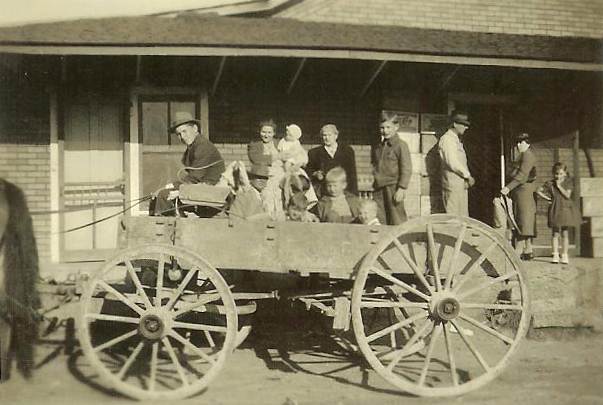
01 Farmer’s Exchange: Wendy in wagon, Ruth and baby Carolyn, Grandma Graves,
Donald, Maurice, Marvin, Mr. Melton Hensley, Aunt Minnie and Wyrick girl
Here is that email:
February 16, 2011
Subject: Wagon Photo
Mr. Pryor
I recently ran across a photo posted on the Miller County Museum site of an old horse drawn wagon. I am a historian, collector and researcher of America’s early transportation industry…dealing especially with vintage wooden wagons. My information, collections and writings have been published by Wild West, Western Horseman, The Carriage Journal, farm Collector and Driving Digest magazines as well as by the American Chuck Wagon Association, National Stagecoach & Freight Wagon Association and others. I am a recognized early western vehicle authority with multiple speaking engagements throughout the year. My website is located at www.wheelsthatwonthewest.com
I am somewhat curious about this photo because there are specific features of the wagon that lead me to believe I may be able to identify the maker. Would it be possible for me to view a higher resolution copy of this photo? Even at the small web resolution I’m seeing elements that point to a particular Missouri maker and would just like to confirm that by being able to see greater detail in the image. Certainly you would be able to add any information I can glean from the photo to your web postings.
Thank you for your time. I look forward to hearing from you.
David Sneed
Wheels That Won The West Publishing & Archives
www.wheelsthatwonthewest.com
|
I had placed the photo of Jim Patterson and his family in the wagon last year on this previous Progress Notes.
So I sent Mr. Sneed a higher quality photo original and here is his reply:
Sent: Mon, March 21, 2011 9:30:58 PM
Subject: Re: from Joe Pryor old wagon
Hello Joe,
Thank you very much for your email and the opportunity to further review the old wagon photos. My supposition that the Patterson photo contained a St. Louis-made wagon proved correct once I was able to see the image in greater detail. The Patterson wagon is in fact a "Gestring" brand wagon. The name is pronounced "Guess-String". It's an interesting brand for a number of reasons - many of which I outlined in several detailed articles I wrote for the September issue of Farm Collector magazine last year (see the links to the on-line versions below).
1. http://www.farmcollector.com/equipment/construction-styles-gestring-wagons.aspx
2. http://www.farmcollector.com/equipment/historically-significant-gestring-wagons.aspx
3. http://www.farmcollector.com/equipment/gestring-white-wagon.aspx
As I'd outlined in one of the stories, archeologists with MODOT finished excavations of this legendary St. Louis wagon maker a little over a year ago. They were working on it as part of the pre-construction documentation of the area which will be covered by a new Mississippi River bridge in St. Louis. Casper Gestring started his firm sometime in the mid to late 1850's and was actually contracted by the U.S. Government to build wagons during the Civil War. His company was on Broadway Street and he competed head to head with some of the biggest names in the early transportation industry.
The logo on a Gestring wagon box is typically located on the center section of the lower sideboard and is very distinctive with a large 'G' at the beginning and end of the hand painted name. Additional features that initially led me to believe this might be Gestring included the unique hardware elements on the spring seat (arm rest designs as well as the metal hanger hook configurations). More features confirming Gestring are the smaller rub iron, the brake hanger system and bolster standard designs. Ultimately, the faded logo on the side of the box provides the final, conclusive evidence of the maker.
Thanks again, Joe, for sending the photos. It is quite likely that MODOT would be interested including this image as part of their research. If your group would like to have their contact info, I'd be happy to share or pass word on to them of this image. Just let me know.
I'd also like to obtain permission to use this Gestring image in my own future writings. Certainly, I'd be happy to include appropriate credits. Can you find out (or point me in the right direction to learn) if I could receive the permissions to use the Gestring photo in my writings?
Thanks again for your time. I hope this information is helpful to your organization.
Sincerely,
David Sneed
Wheels That Won The West® Publishing & Archives
"America's Largest Private Collection of Western Vehicle History"
www.wheelsthatwonthewest.com
|
In the first of Mr. Sneed’s websites I listed above he gives a very detailed description of the Gestring wagon and its history.
I will have to admit that I was not very well educated in the various wagons which might have been for sale in those days long ago before we had good roads or cars. I remember as a child that a couple of people still were coming to town in a team drawn wagon (Rig Patterson and half brothers Orb and Otto McCaslin) but I didn’t know much about any brand names of wagons. In fact, I had thought that about all the wagons around Tuscumbia had been made by John Kallenbach, and his half brother John Edward Kallenbach, certainly two of the county’s most well known wagon makers. Here are photos of John Kallenbach and one of his wagons (photos 03 and 04):
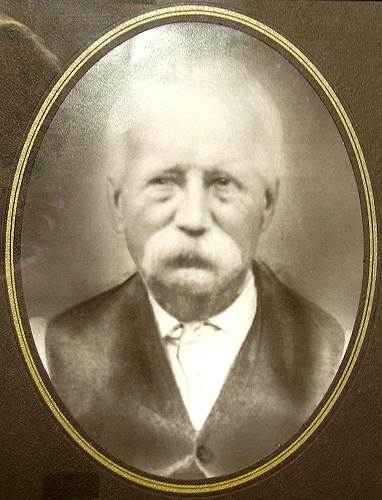
03 John Kallenbach
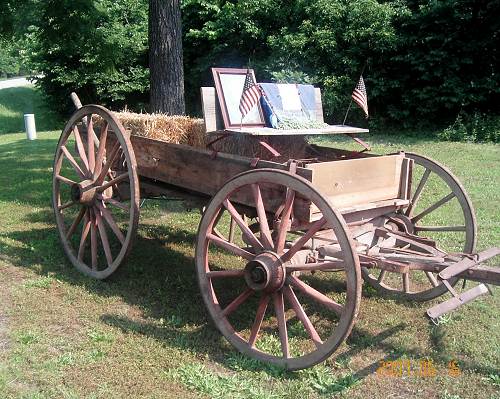
04 Kallenbach Wagon owned by Brice Kallenbach, Grandson of John
John Edward Kallenbach will be discussed later.
But Mr. Sneed is an expert in these matters so I didn’t doubt that the Pattersons were owners of a Gestring wagon, one of America’s really well known wagons for those times. I called Marvin Patterson, son of Jim Patterson, and asked him from where the wagon was obtained. He told me that his father, Jim, purchased it from the Anchor Milling Company in Tuscumbia. In fact, he said it is still in existence although not useable due to decay and rust.
The circumstances which have created an interest in the Gestring wagon manufacturing company have to do with the preparations for the construction of a new bridge planned in St. Louis to cross the Mississippi River. The Missouri Department of Transportation has taken great preparation to preserve important historical structures, which over time have been buried or collapsed in the area in which the bridge is to be built. Also, the bridge is being built in an area of one of the many famous prehistoric mounds for which St. Louis is known. I went to the MODOT website to learn more about the archaeological work being done, especially as it related to the Gestring wagon. Copied from the website below is this article:
One of the first properties identified during the survey for the New Mississippi River Bridge project in St. Louis was the Gestring Wagon Factory, a mid-19th to early-20th-century factory located at the northeast corner of N. Broadway and Mound streets. Although the property was identified as potentially significant early on, archaeological testing did not take place until the summer of 2009. At that time, the site was determined to be remarkably intact and historically significant, with the potential to provide unique information on the development of wagon and carriage manufacturing in St. Louis.
The Gestring Wagon Company was founded by Casper Gestring (1833-1903) who had immigrated from Germany in the mid-1850s. Starting as a blacksmith, Gestring soon opened a shop at the northeast corner of N. Broadway and Brooklyn (a block north of the eventual Gestring factory). After shoeing horses for the Union Army, Gestring and his partner Henry Becker opened a wagon shop a block south in 1866. In 1875, Gestring and Becker constructed a larger factory in the southwest corner of the same property. The new building had four stories, plus a black-smith shop in the basement, and employed 35 craftsmen. The company continued to manufacture hand-made farm wagons well into the 20th century, while their closest competitors shifted to the automobile. Finally, in 1935, the Gestring Wagon Company closed its doors, ending the age of the hand-made wagon.
Along with the John C. Kupferle Brass Foundry, the Gestring factory is located on the former location of Big Mound, the northern most member of the St. Louis Mound Group. Written accounts of the mounds date back to the earliest days of St. Louis, but the best account was by Dr. Thomas Say and Titian Peale (members Major Stephen Long’s scientific expedition) in 1819. The two men made a detailed survey of the mounds, producing a map showing the relative size and arrangement of the mounds, including Big Mound. The base of Big Mound measured approximately 319 x 158 feet, with an estimated height of 34 feet (Marshall 1992). The mound survived relatively intact until the 1840s. However, starting in the late-1840s and accelerating over the next two decades, development in this part of St. Louis led to the degradation and eventual destruction of the mound. In 1869, photographs and newspaper accounts document the last remnants of Big Mound being hauled away to be used as fill for the railroads.
Excavation of the Gestring Wagon Factory was conducted in October and November, 2009. The object of the excavation was to study 19th-century industry in St. Louis, and at the same time take an intensive look at the location of Big Mound. Portions of five buildings were excavated: the wagon shop built c. 1866, the factory building built c. 1875, a separate blacksmith shop, a warehouse, and the family residence built c. 1892. Other features associated with these buildings and excavated include three cisterns, a sump, a privy, a refuse burner, and eleven forges. A significant portion of the property was mechanically excavated in an attempt to identify prehistoric, sub-mound features; no evidence of intact prehistoric deposits were found, although a handful of prehistoric artifacts were recovered from inside one of the cisterns. Artifact analysis is currently underway, and a technical report will be made available when completed.
Marshall, John B.
Here are some photos taken by MODOT at the site of the area where was found the remnants of the Gestring wagon factory (photos 05, 06 and 07):
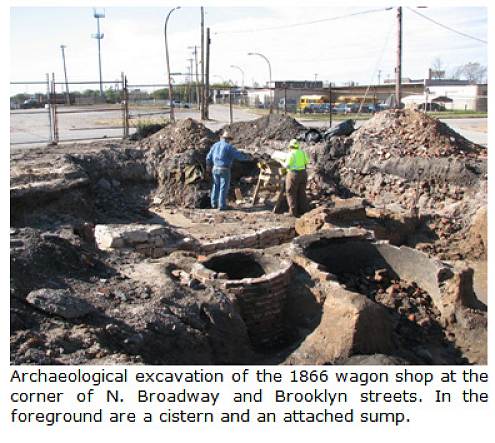
05 Archaelogical Excavation
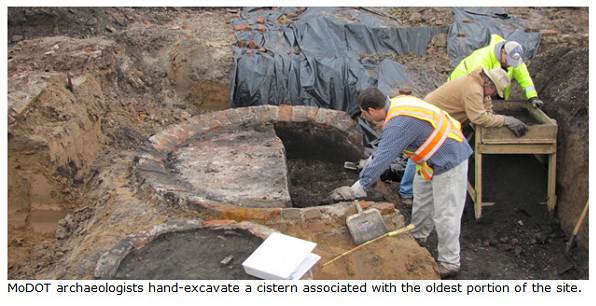
06 Cistern
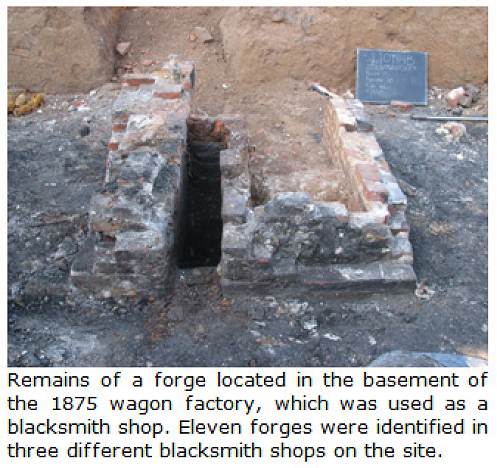
07 Old Forge Remains
Returning to the Patterson wagon photo which created all the interest for the wagon maker historians, I asked Carolyn Patterson, sister to Marvin Patterson, to name the people in the wagon and around it. She consulted with Marvin Patterson, her brother, and wrote me the following (for convenience photo 01 above is repeated as photo 08):
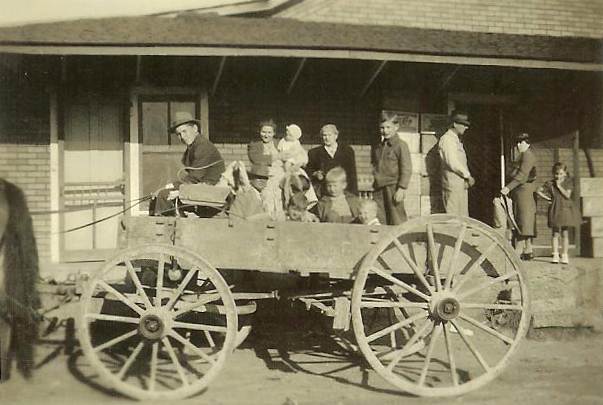
08 Farmer’s Exchange: Wendy in wagon, Ruth and baby Carolyn, Grandma Graves,
Donald, Maurice, Marvin, Mr. Melton Hensley, Aunt Minnie and Wyrick girl
“Joe,
I can help you here, except for the three standing...wonder if the two are Aunt Minnie Lupardus Patterson and Myna by her having the pic? Not sure who the man is talking to them on the end.
Others are: William Wendell Patterson driving the wagon, our dad with the hat on, James Willard Patterson, Marvin Lane Patterson, Maurice Lynn Patterson, Harold Allen Patterson and Donald David Patterson standing. Standing in front of the Ulman MFA exchange are mom, Ruth Elizabeth Graves Patterson holding me, Carolyn Ann Patterson Pryor and then her mom, grandma Anna Elizabeth Wolverton Graves. I was born in July, 1944, but this is a bit after that as you can see for I am holding up pretty good, so not sure about the date. I know Babe was away in the service when I was born and he had just come home on leave Mom said and as he was leaving down the driveway lane, he turned and waved good bye again to them and yelled back "tell Josephine hi for me when she is born" and mom said she always regretted not naming me Josephine, personally glad she didn't though. I am assuming that James, Bob and Warren were already in the service too judging by the age of Wendell, for he is grown up here.”
|
No doubt, to buy a St. Louis made wagon would cost more I would think than to have one made locally. But certainly, at least early on in our county’s history, quite a few individuals around the county made wagons. Just a short search of our own records in the Miller County Museum website found the names of several wagon makers around the county. I will attach here a compilation of those URL’s found on our website (photo 09).
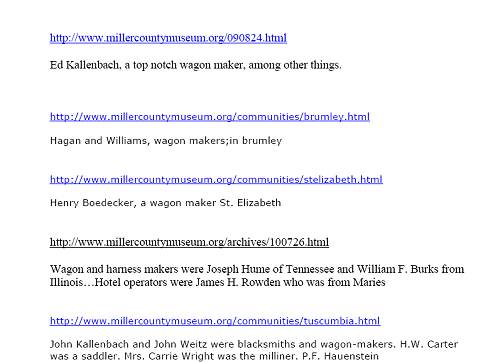
09 Websites of Wagon Makers
Click image to read entire document in PDF format
In one of C.B. Wright’s narratives he wrote about the early days of poor roads and wagons. Copied here is his essay (photo 10):
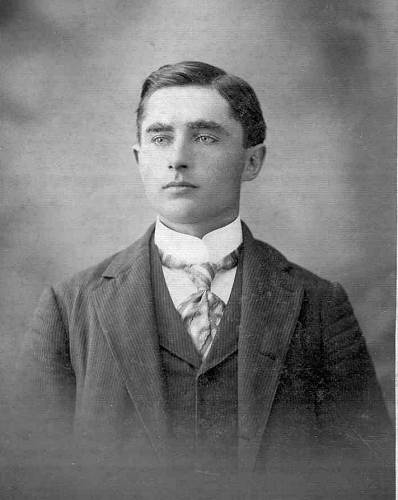
10 Clarence Boyce Wright
Roads and Travel (from a personal journal of C.B. Wright)
Before the advent of the motor car, this county had no improved roads of any consequence, and for the most part, country people had only the farm wagon as a means of transportation. Now and then a farmer would own a spring wagon, hack or buggy. Jack (J.R.) Wells had a carriage with a covered fringe around the top. Dad (Green Lee Wright) had bought a hack several years before the motor car. While Richard and Homer Lee Wright were still at home (brothers of C.B.) they cut up a sizeable load of walnut logs for which they got about $125.00. A storm on the creek had blown down a few good walnut trees and that was one of the reasons for them wanting to harvest the logs. It took the boys a good long time to get the load out of the woods and haul it on a large wagon to Eugene. With part or all of this money they bought a buggy and aside from what the Wells folks had it was the only one in the school district. John Kallenbach, who was one of our best wagon makers, had built a heavy hack or spring wagon for his own use which was rather exceptional for the area and quite admired. Some other community may have had more or less of what I described above but our district was probably about on the average.
And there was not much prospect shown by the county to help us have a good roads system other than some of the main routes which were barely maintained. Because of the lack of funds to enable the county to build roads for the farmer, most any landowner, if he decided to make a road or a road change, could go to the county court with a petition which usually was granted without requiring supervision. All the farmer had to do was clear the timber out for the proposed road…and lo! It was a road. The most flagrant case of this sort was pulled off by some of the Artz family. They cut out a road, or I mean the right of way, for about one half mile of timber of right good size. The cut out road ran south from near the Musser Tavern mostly on the downgrade, then making a corner, running one half mile east to make a connection with the old road. At that time the Tuscumbia mail was coming to us via West Aurora. But this road change made the neighbors more or less angry or sore because it caused the mail route to miss their properties.
When the farmer wanted to go visiting or picnicking he loaded the wife and kids in the farm wagon…the bed being first filled with hay, straw or other wise. If the weather was cold, hot bricks were put in too. The kids would have quilts to cover and that was the way they went."
When going to picnics such as the one in Aurora Springs there would be good big crowd there already in the morning because to get home before night fall everyone wanted to leave early.
One of John Kallenbach’s half brothers, John Edward (Ed) Kallenbach, also made wagons in his shop in Tuscumbia (photo 10a).
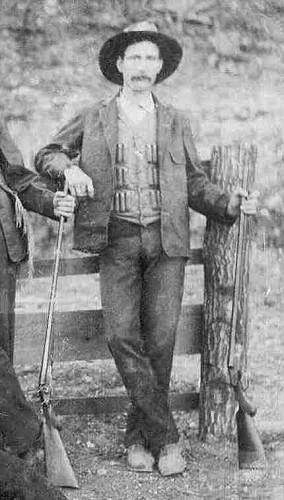
10a Ed Kallenbach
His son, Dewey Kallenbach, in the 1960’s made a model of his father’s wagon. An article about the model as well as Dewey’s father, Ed Kallenbach, was published in the Miller County Autogram sometime in the 1960’s. The clipping from the paper I have did not include the date. Here is the photo of Dewey with the wagon followed by the article (photo 10b):
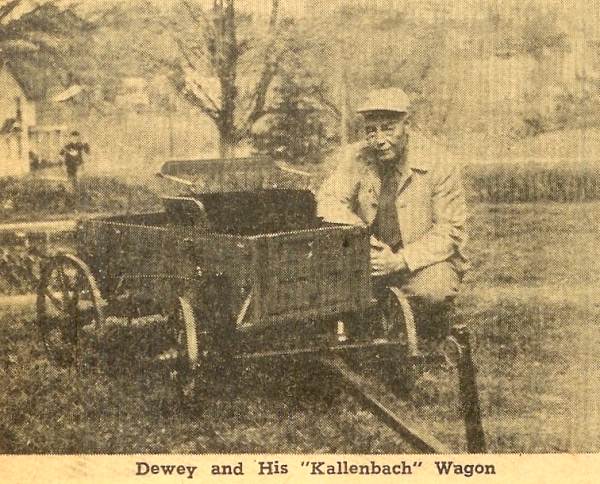
10b Model Wagon built by Dewey Kallenbach
Miller County Autogram
Date unknown: approximately 1960’s
As time moves along and the ways of life make a gradual change, some of the older arts finally become lost as more modern methods of living come into existence. The art of wagon making, which at one time was an essential business in any thriving community, finally gave way to the modern garage.
Such was the case of the Kallenbach blacksmith shop, which opened in Tuscumbia many years ago. In 1880, J.E. Kallenbach became the leading blacksmith in this Miller County town and continued to operate the shop until 1916 when Mr. Kallenbach converted the shop into a garage. About 1938, he retired from his work and still lives in Tuscumbia.
The blacksmith shop was located on the river bank near the old Anchor Mill office. There Mr. Kallenbach made the wagons, which bore his name for a period of 56 years.
A few days ago, a son of the wagon maker, D.E. (Dewey) Kallenbach of Tuscumbia, made a replica of his father’s wagon. Every part of the miniature model is made to scale and reproduced by the same process used by the father. The wagon bed is 18 inches wide and 43 inches long; the back wheels are 18 inches high and the front wheels stand 14 inches high.
Mr. Kallenbach used native oak which had been seasoned 20 years for the model with the original axels and boxings. The small wagon is complete in every detail including sideboards, brakes, single trees, neck yoke, an adjustable coupling pole and hand made spokes.
The metal tires were heated over an open fire and were shrunk on the wheels to insure tightness.
The model wagon bears the same colors as the old Kallenbach wagons. The running gears are red, striped with black while the bed is a bright green with yellow striping.
Mr. Kallenbach has his wagon on display at his appliance store in Tuscumbia. No doubt to many of Miller County’s citizens, the small wagon will bring back many memories of early life in Miller County.
Those who visit in the home of Mr and Mrs. D.E. Kallenbach of Tuscumbia will see many fine pieces of furniture which Mr. Kallenbach has made in the home basement. The card tables, desks, chairs , corner what nots, inlaid pictures, and many other pieces of furniture have been made and finished with skill. No doubt, Mr. Kallenbach first developed the interest of wood craft from his father , who worked so many years as a prominent wagon maker.
Finally, it occurred to me that some readers may not know precisely the difference among a wagon, hack, hackney, carriage, buggy, coach and so on. Many times some of the words are used interchangeably because by and large it just doesn’t make that much difference anyway. Well, here is a list of all the names of horse or beast drawn wheeled vehicles with a short definition for each (photo 11):
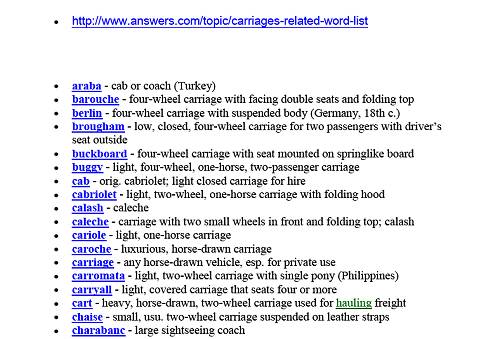
11 Complete list types of Wagons
Click image to read entire document in PDF format
Last week I featured an Ameren (formerly Union Electric Company) DVD which recorded the memories of some of the local people who were involved with the construction of Bagnell Dam in the years 1929-1931. One of those interviewed was Loyd Sandfort, whose family was one of those which was early to settle in our county (photo 12):
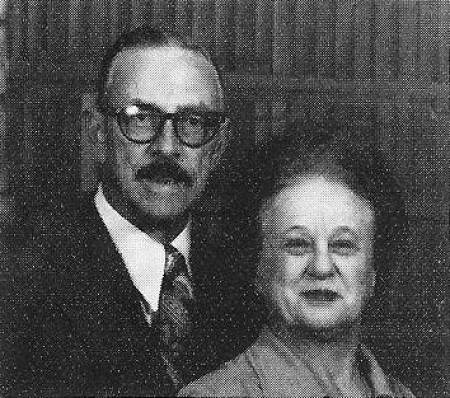
12 Mr. and Mrs. Loyd Sandfort
(Note: I am using the spelling Loyd rather than Lloyd because the first spelling is the one used by the family itself for his biography published in the 50th Anniversary Lake of the Ozarks book.)
This week I will present some of the Sandfort family history.
Peggy Hake has summarized on our website a short narrative about the Sandfort family which I will copy here:
John F. Sandfort married Susannah Wyrick in Cole County, Missouri on 9/5/1844. He was a son of John C. & Wilhelmina Sandfort, natives of Germany. John was born in Germany about 1822.
Susannah & John became parents of four children including:
- 1. John H. Sandfort born 1847 m. Harriett W. Bowlin 3/5/1871
- 2. Susan Mary Sandfort born. 10/26/1848 m. James Benjamin Cotten, 6/3/1866
- 3. Wm. Thomas Sandfort born 2/26/1850 m. Sarah Ann Cotten 8/7/1870
- 4. Unknown child who probably died young.
According to family legend, John F. Sandfort left Miller County in the early 1850s and went to the California gold fields, but never returned. He must have died along the way or in California between 1850 and 1856. Later, Susannah married Joshua Vaughan in Miller County on 11/11/1856.
Many Sandfort family members now living in this county are descendents of William Thomas Sandfort, son of John F. Sandfort listed above by Peggy as having gone west and never returned. Early information indicates that William Thomas Sandfort and his siblings were brought to Miller County from Cole County by their mother, Susannah, after she married Joshua Vaughan of Miller County. William Thomas Sandfort married Sarah Cotton and early on lived in Franklin County north and west of Bagnell. In the 1905 plat map of the area he is listed as being a property owner in Sections 7 and 8 of T40N R15W (photo 13).
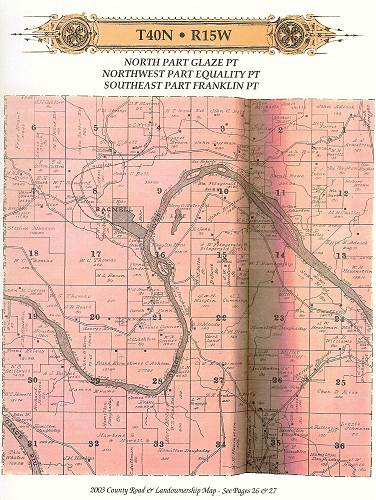
13 T40N R15W - 1905
Click image for larger view
His obituary offers more information:
William Thomas Sandfort
William Thomas Sandfort was born in Cole County, Missouri, February 26, 1850, and died April 20, 1930, being at the time of his death, 80 years, one month and 25 days old.
He moved with his mother in early childhood from Cole County to Miller County, where he has spent the remaining part of his life.
He remembered his Creator in the days of his youth and gave his heart and life to Jesus as his Savior and joined the old Blue Spring Baptist Church. When he was just yet a young man, and his life has been one continual traveling and that was to that land of promise where his weary soul has found that rest that remaineth for the people of God. It was truly said of Brother Sandfort as of Barnabus of old, he was a good man.
He was united in marriage to Sarah A. Cotton August 7, 1870. To this union twelve children were born. Some four years ago, his good wife was called to her Heavenly home where she has been waiting for him. He has laid to rest six of his loving children. There are six yet living whose names are as follows; Mrs. Nanie Scott, Eldon, Mo.; Mrs. Florence Houser, Eldon Mo.; Mrs. Jain McFarling, of Springfield, Mo.; Mrs. Rose E. Snyder, Wichita, Ks.; Edgar Sandfort, of Jefferson City, Mo.; and William Sandfort, of Bagnell, Mo. He had forty one grand children and seventeen great grandchildren. To those who are left behind, it is true you have lost a dear and loving father, but he has gone to join his good wife and the other children where parting will be no more.
The funeral was conducted at the Blue Spring Church by the pastor, Robert A. Wood, using for a text a part of the 38th verse of the Third Chapter of the Second Book of Samuel, “Know ye not that there is A Great Man Fallen this day in Israel.”
Rev. Robert A. Wood
Card of Thanks
We wish to express our many thanks to our neighbors and friends for their kindness and help during the sickness and death of our father. Also for the many flowers which were mightly appreciated.
Mrs. J.L. Howser and Family
William Thomas Sandfort was known as an excellent carpenter possessed of great talent for wood working of all kinds. He was known as being especially skilled at building church pews and coffins. Here are some photos of one of his pews which originally was made for the Blue Springs Baptist church, now in the possession of Clark Sandfort, a great grandson of William (photos 14 - 17):
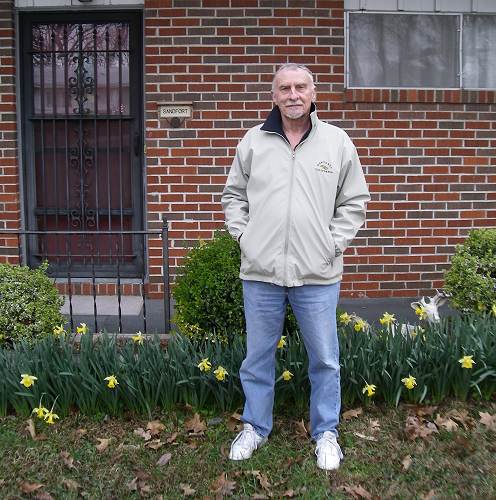
14 Clark Sandfort
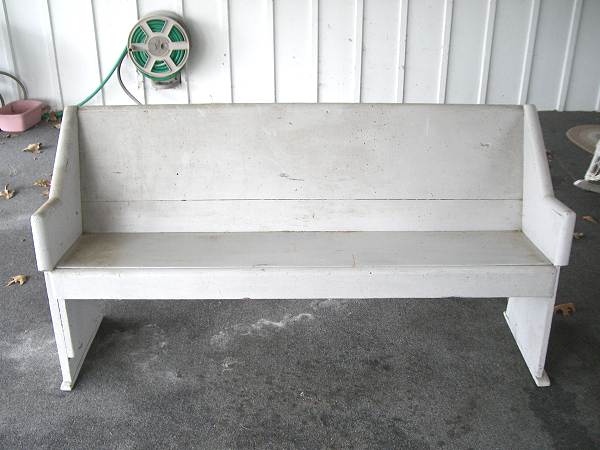
15 Blue Springs Baptist Pew
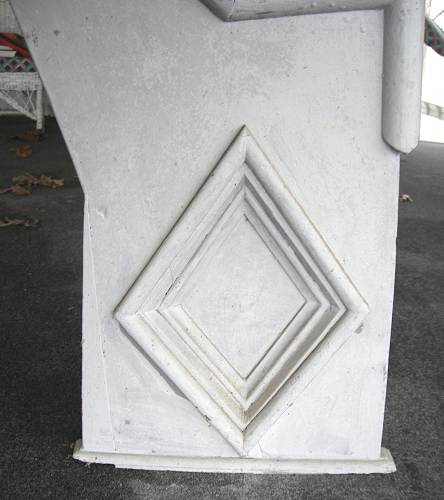
16 Blue Springs Baptist Pew
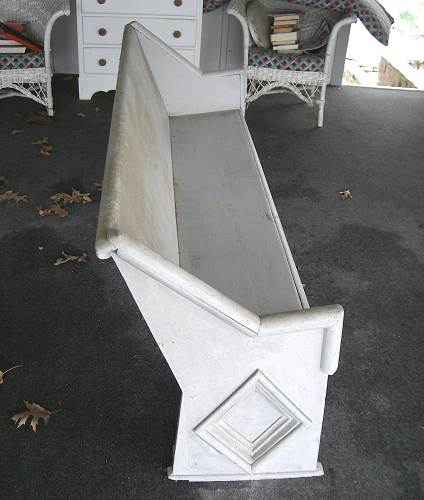
17 Blue Springs Baptist Pew
Clark has been very helpful to me in researching information and giving me a tour of the area where the Sandfort family settled and where several still live today. Howser Sandfort, Clark’s father, was interviewed by Howser’s nephew, Leland Standfort, in 1980 in which Howser recorded his memories of his grandfather William Thomas’ woodworking skills:
COFFIN MAKING
By Leland Sandfort
The following is an interview with Howser E. Sandfort concerning his grandfather, Tommy Sandfort (William Thomas Sandfort, father of William Riley Sandfort), and his part time business of coffin making. The interview was made at Mr. Sandfort's house on the evening of May 14, 1980:
"Grandad was a farmer... He built the caskets on the side. What he done, he used walnut logs. He cut the logs. He had the lumber sawed ahead of time. He kept a stack ahead of time all the time stacked in the barn to dry. Back then they had no power tools whatsoever. He done it all with hand tools which were inferior to what our tools are today. They were wood but they had good metal in them. You could sharpen a plane or something like that but they were wooden planes and the only piece of metal about them was the blade itself and everything else was wood and to adjust it you had to set it just right and tap it down. It would be a heck of a job to build something today with tools like them.
When people wanted a coffin they just couldn't give him a call, they would get in touch with him. They would have to go and tell him they wanted a coffin and he would build it. I think he did at one time probably build a few caskets ahead of time and have them made. A lot of people would tell him they wanted a casket when they did die and to have it ready for them and he would go ahead and build it."
He made different sizes?
"Oh yeah he made different sizes and I guess pretty well one shape. They weren't just a box - they were sort of tapered. He made a lot of them that are in the ground around here. I think he quit making them around 1918 because I remember when Grandma died - she died in 1922. I wasn't very old. As a matter of fact, I was seven years old then. We were over to their place of course and were down to his work shop and the tools weren't being used very much at that time. I can remember that because the fact of the matter was I got so interested in playing around 1n that workshop and playing with the tools that the folks went off and left me.
They got the kids all together - or thought they did - and had them all in the wagon and got down to the Cotton Spur which is down where Bob Vaughn lives now. That is how far they had gone when they realized they had gone off and left me. In the meantime Grandad had found me. He had harnessed up his old mules. Their names were Torn and Jerry and he hitched them up and put me in the wagon and started out. We met them coming back after me down there at the Lige Stark place which is where Dennis Gier lives now. They lived on up past the old school house in an old log house.
I remember he used screws. As I remember they must have been copper or brass. He put them together with screws. They were not ordinary screws but were brass colored and bought special for that. That is about all I can tell you. They were just plain. They would be considered very plain today. They lined them on the inside with cloth of some kind.
Honestly, I can't tell you exactly where any of them are now but there are some in just about every cemetery around here."
Were the trees big enough to have each board one piece?
"Yeah, he sawed big, wide lumber. He sawed big logs."
First growth timber - never cut before?
"Yeah, he sawed first growth timber and then he planed that stuff to get some smooth boards. I can remember the boards that looked two feet or more then he stacked it and air dried it. He didn't have any way to kiln dry it. Then he planed it with a hand plane to smooth it and no power saw or anything. Anything that had to be ripped or cut was done with a hand saw."
I have a hard time putting two 2 x 4's together. He didn't make that much money from it did he?
"Well it was just extra income for him, He was a farmer but he had this business on the side.”
Did many people do that?
"He was the only one I know of around here. There may have been others but. I don't know of any. Of course I was pretty young but I do know that when Grandma died and I was playing in his shop he had quit. I expect probably by then they were factory made and everyone wanted a factory made one."
Did they finish them on the outside?
Yeah. I don't remember what they put on them but they planed them smooth and put something on them but I don't know what."
They probably didn't have that much back then.
"Oh, I am sure they had varnishes but I don't know what he used. He probably used some kind of sealer or varnish of some sort."
If that walnut was dried out before he used it those things would last forever.
"Oh yes. I'll bet you there are still some of them out there today."
If those were brass screws I wonder if there was· any brass trim on them.
"Yes. There was some brass trim but I don't remember what."
Of the children of William Thomas Sandfort most of the descendents now living here locally with the Sandfort surname are progeny of William Riley Sandfort, son of William Thomas Sandfort. Because William Thomas had several daughters, some of their descendents live in the area as well but with other surnames.
At some point in time, either William Thomas or William Riley Sandfort purchased a large tract of land east of the original Sandfort property identified above in the 1905 plat map (photo 13 above). This second tract of land, mostly still owned by Sandfort descendents, is located on Catrock and Allen Roads very close to their intersection with Highway 54. It has been thought that the purchase was made shortly before the Bagnell Dam was constructed since some of the original Sandfort land was predicted to be inundated by the Lake after completion of the Dam.
William Riley Sandfort married Emma Electa Howser in June of 1904 (photo 18).
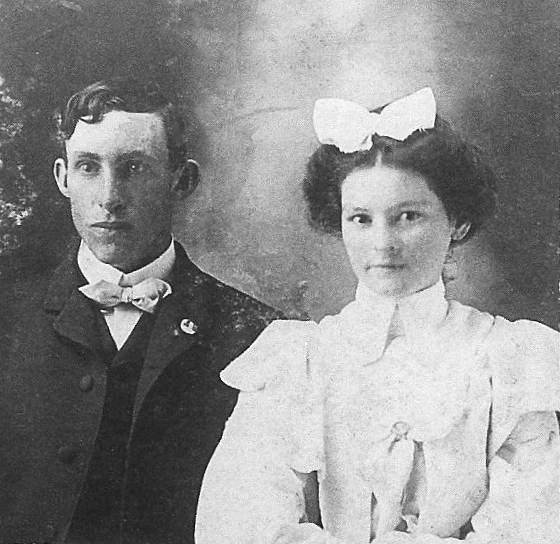
18 William Riley and Emma Electa (Howser) Sandfort Wedding
They raised their large family in a log house William built which was located very close to the north side of Catrock Road only a short distance from its intersection with Highway 54. Only a few old rotting logs on the ground now remain of this old home. Here is a photo of William and Emma in front of their home when they were much older (photo 19):
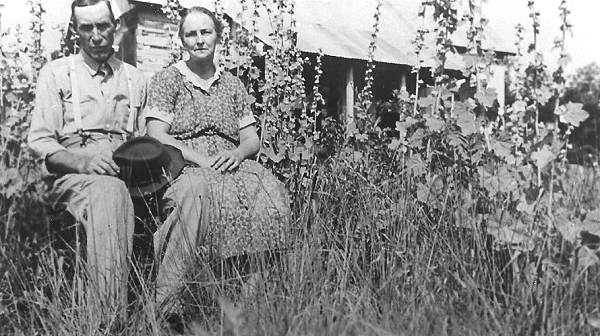
19 William Riley and Emma Electa Sandfort's Last Home
They had fifteen children which are named in this list supplied me by Clark Sandfort, son of Howser Sandfort (photo 20).
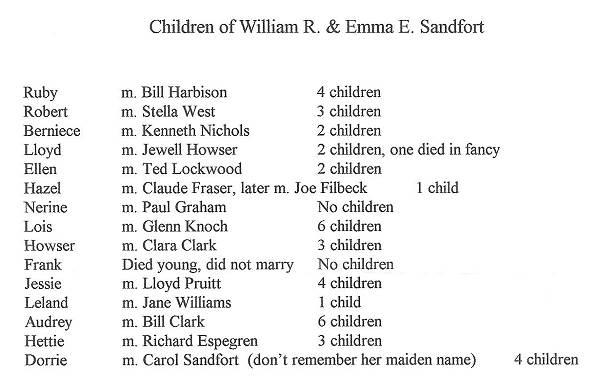
20 Children of William R. and Emma E. Sandfort
Clark told me that one of the enterprises of his grandfather William Riley Sandfort was a sugar cane press from which were made many gallons of molasses through the years. Clark said local people from miles around came each fall to purchase the molasses made by William.
Here is the obituary of William Riley Sandfort’s wife, Emma Electa Howser Sandfort which gives more family information:
Obituary: Miller County Autogram Sentinel, Thursday, November 9, 1967
Funeral services were held at 2 p.m. Tuesday at Mt. Carmel Baptist Church for Mrs.
Emma Electa Sandfort, 81, a resident of Miller County throughout her lifetime. She lived some nine miles south of Eldon in the Bagnell area. Mrs. Sandfort died at l7 a.m. Sunday, Nov. 5, 1967, at Still Hospital, Jefferson City, where she had been a patient for one week.
She leaves 90 living descendants in four generations. She was born May 7, 1886 in Miller County, a daughter of the late Andrew Jackson Howser and Elizabeth Victoria (Wilcox) Howser. In June, 1904, she was married at Tuscumbia to William Riley Sandfort. He died in 1941. A daughter and a son also preceded their mother in death.
Mrs. Sandfort was a member of the Mt. Carmel Baptist church.
Surviving are eight daughters, Mrs. Ruby Harbison, Eugene; Mrs. Ellen Lockwood, Kansas City; Mrs. Lois Knoch and Mrs. Audrey Clark, Lake Ozark; Mrs. Nerine Graham, Baton Rough, La.; Mrs. Hettie Espegren, Sacramento, Calif.; Mrs. Berniece Nichols, Jefferson City; and Mrs. Jessie Pruitt, Eldon; five sons, the Rev. Robert Sandfort, Osceola; Howser Sandfort, Lake Ozark; Major Dorrence Sandfort of the Air Force who lives at Upland, Calif.; and Loyd Sandfort and Leland Sandfort, Eldon.
Also surviving are one sister, Mrs. Hettie Kehr, Kansas City, Kan.; one brother, Lilburn Howser, Lake Ozark; 40 grandchildren; 36 great-grandchildren; and one great-great-grandchild.
The Rev. Louis Elseman officiated at the services Tuesday. Burial was in Blue Spring Cemetery under the direction of Kays Funeral Home of Eldon. Pallbearers were Clint Meredith, Curtis Beach, Burnham Howser, Joe Brown, Robert Ward and Burdette Conner.
As noted above, William Riley and his wife Emma had fifteen children. One of those was Howser Sandfort, father of Clark Sandfort, who was the family member who helped me gather the information about the Sandfort family. Howser was quite successful and well known for the construction company he owned and operated, now managed by another son, Roger Sandfort, who is a brother to Clark. Howser is deceased now but I thought readers would be interested in reading his autobiography as published in the book Lake of the Ozarks 50th Edition:
Howser E. Sandfort Family (1980)
I, Howser E. Sandfort, was born and reared in Miller County, son of William and Emma Sandfort, one of fifteen children. In 1938 I was married to Clara Clark, daughter of James A. and Lillie Clark, also natives of Miller County. We lived in Mexico, Missouri, where I was employed as construction foreman for A.P. Green Fire Brick Company for six years. We moved back to the Lake area in 1941 where I was employed as construction foreman for A.E. Feager Construction Company. In 1945 I formed my own company known as Sandfort Construction Company, which I operated until 1969 and is well known in the Lake area.
We have three children, all graduates of School of the Osage: William Clark, who lives in Los Angeles, California; Sara Sue, married to Harry Chalmers of Eldon, Mo. now living in Vacaville, California. They have three children: Melissa, Shane and Jackie; Roger E. married to Sonna Rae Lind and lives on Rt. 3, Eldon, Missouri. They have three children, Brad, Julie and Larry, all three students of School of the Osage.
Roger is now owner and operator of Sandfort Construction Company which he bought from us in 1969, after returning from California where he worked for Maher & Hess Construction Company for 5 years.
We now live on Highway W on the north shore. We are semi retired, do some traveling, and spend some time each year with our children and grandchildren in California, which we enjoy very much, but we always return to the Lake area and home.
Submitted by Howser E. Sandfort
Here is a photo of Howser and his family which accompanied the narrative in the Lake of the Ozarks book (photo 20a):
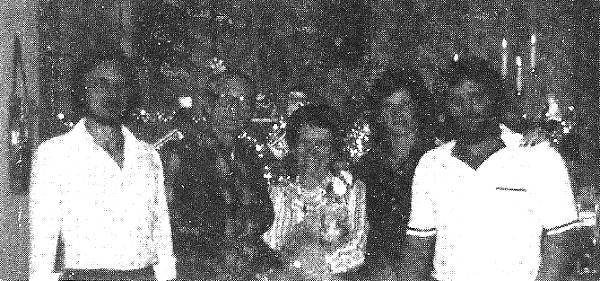
20a Clark, Howser, Clara, Sara and Roger Sandfort
Clark told me that Howser, his father, was the builder of the Lake Ozark
Christian Church in 1953. Because of a limit to the budget some wooden arches
had to be eliminated. However, Howser built the arches at no cost to the church.
Clark accompanied me the other day to the church so I could take these photos
(photos 20b and 20c):
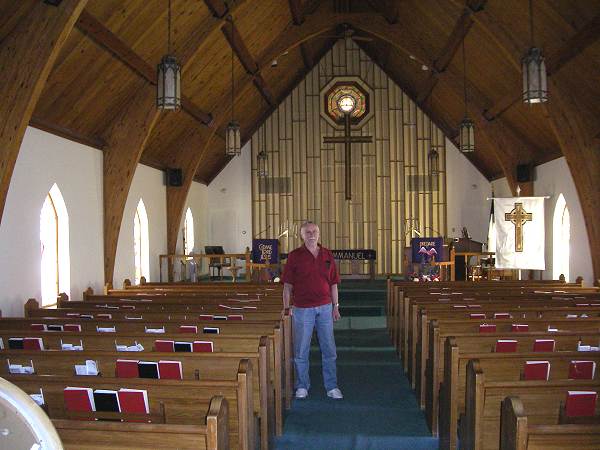
20b Clark in church his father built
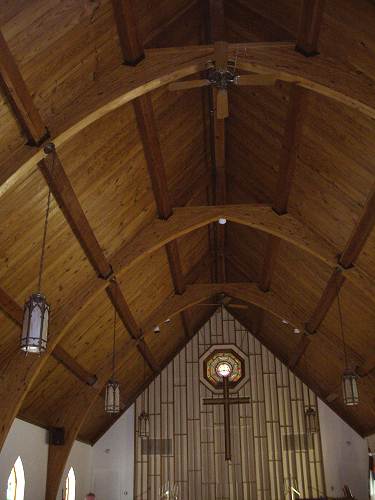
20c Arches made by Howser Sandfort
Clark said he himself was the first organist at the church in
1953 for a wedding; however, he was not a member of the church, his family went
to Riverview Baptist. Reverend Alexander was the first minister, according to
Clark. He told me that Reverend Alexander also taught history at School of the
Osage. The photos are of the original church which now is a chapel. Of course,
through the years the church has expanded greatly in size.
The Sandfort descendents of William and Emma have played an important role in Miller County history throughout the last century, especially in the professions of construction and carpentry. Their grandchildren attended School of the Osage after it was established, and many of them as well have had successful careers in various areas locally or out of state as well.
Recently, School of the Osage graduate, Donna Shockley Carrender, reconditioned a copy of the first School of the Osage yearbook published in 1935. It gives an excellent history of the early years of the school featuring many photos of students, faculty and others who played an important part in the school’s development. You can review the entire book here (photo 21):
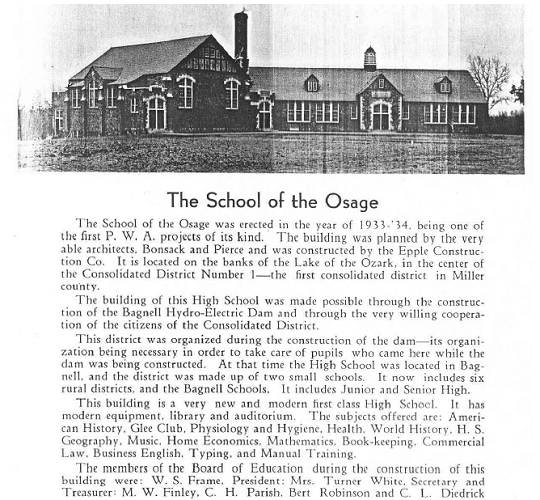
21 School of Osage First School Annual
Click image to read entire document in PDF format
I found a newspaper clipping in our files of an older article written for the Autogram by Peggy Hake (photo 22).
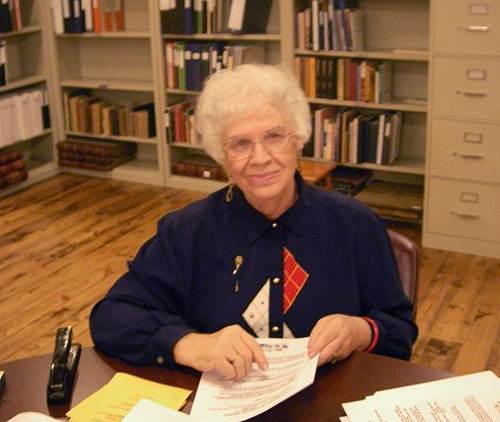
22 Peggy Hake
It will be of interest to long time Iberia residents, especially since over time some of the older buildings referenced by Peggy no longer are standing.
Miller County Autogram-Sentinel
Iberia Post Office (photo 23)
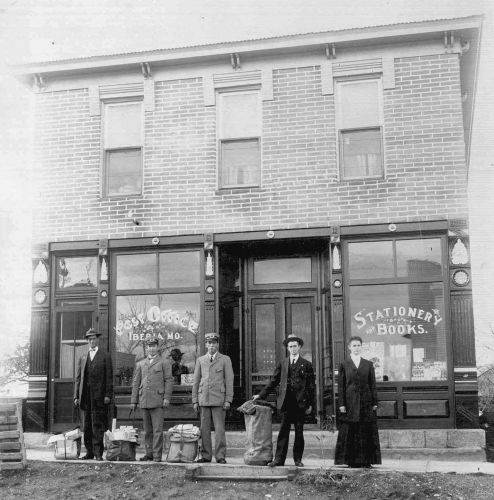
23 George Martin Store and Post Office
Peggy Hake
Date unknown
Do you recognize the above building? It is still standing quietly on Lombar Avenue. It is owned today by Oscar Wilson and is used as a storehouse for his hardware store. I remember it so vividly as the home of the Iberia Sentinel. When I was a young girl, growing up in Iberia, the downstairs area housed the offices and printing shop for Iberia’s grand old newspaper, THE IBERIA SENTINEL. The upstairs area was the home of Glenn and Vera (Porter) Martin. Glenn was Assistant Editor of the Sentinel in partnership with his father.
I wish to thank Lena Heltzell, a daughter of George and Laura Martin, and Glenn and Vera Martin, the son and daughter in law of the Martins who reminisced in wonderful memory about this old building and I learned much about its history as I visited with them.
This picture, belonging to Mrs. Dorothy Barry of St. James, was photographed circa 1907-1910. Standing in front of the building, left to right, are Clifford Clark, John Musick, Harry Ferguson (who were the rural mail carriers), George Martin and Laura Martin. George Martin was the Post Master of Iberia and Laura, his wife, assisted him (photo 24).
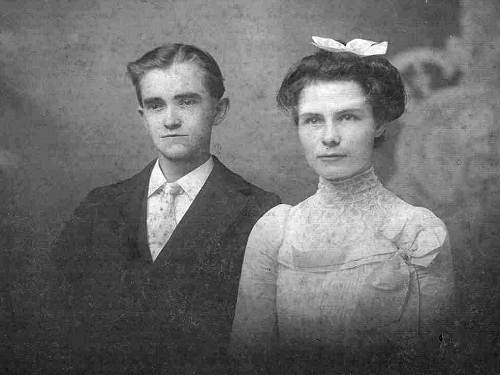
24 George and Laura Ferguson Martin
The window to the right of the picture was a Stationery and Book Store operated by Laura. Earlier in 1905, a post office was located on the lots between the Earl Kinder home and the Forest Green Real Estate office. It was a small wooden structure owned by John Clark and rented by George Martin for the use of a U.S. Post Office. Sometime between 1905-1907, George constructed the two story building shown in this picture. He moved Iberia’s post office to this new location and used the four upstairs rooms as living quarters and it was there he and Laura reared their children. The double doors entered into the Post Office and Book Store (photo 25).
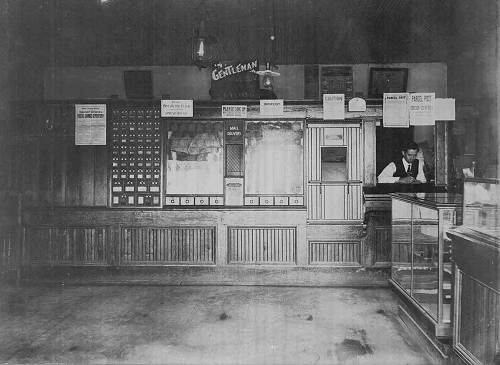
25 George Martin - Postmaster
Click image for larger view
The single door on the left was a stairwell leading to the Martin’s home upstairs. In later years, an upstairs porch, supported by four brick pillars, was added to the original building and they remain today (photo 26).
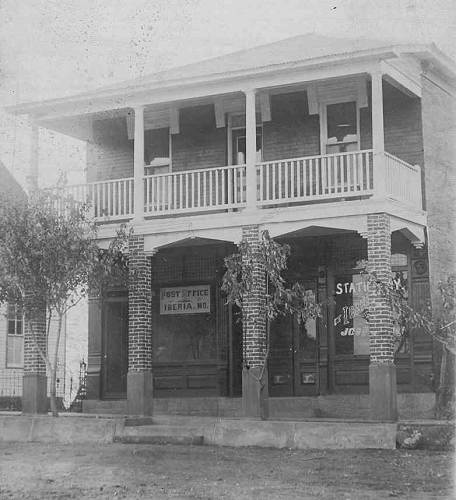
26 Post Office Building remodeled with Porch
George bought the IBERIA SENTINEL in the early 20th century and converted the building into a printing shop and newspaper office (photo 27).
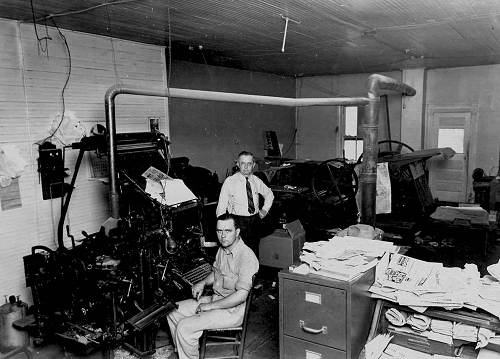
27 Glen Martin sitting - George Martin standing - Iberia Sentinel
Click image for larger view
The post office was then relocated to an old building that sat on the site of Law’s Oil Company of today. The new Post Master was Brose Dickerson. The building was one of the structures destroyed in Iberia’s devastating fire in 1939.
This old building pictured, is gradually fading into the past facing the same fate as so many others in the days gone by. Progress has a way of swallowing up priceless history and only through old photos and the memories of a special generation can any of these buildings be preserved.
Thanks Peggy.
That’s all for this week.
 Joe Pryor
Previous article links are in a dropdown menu at the top of all of the pages.
|

